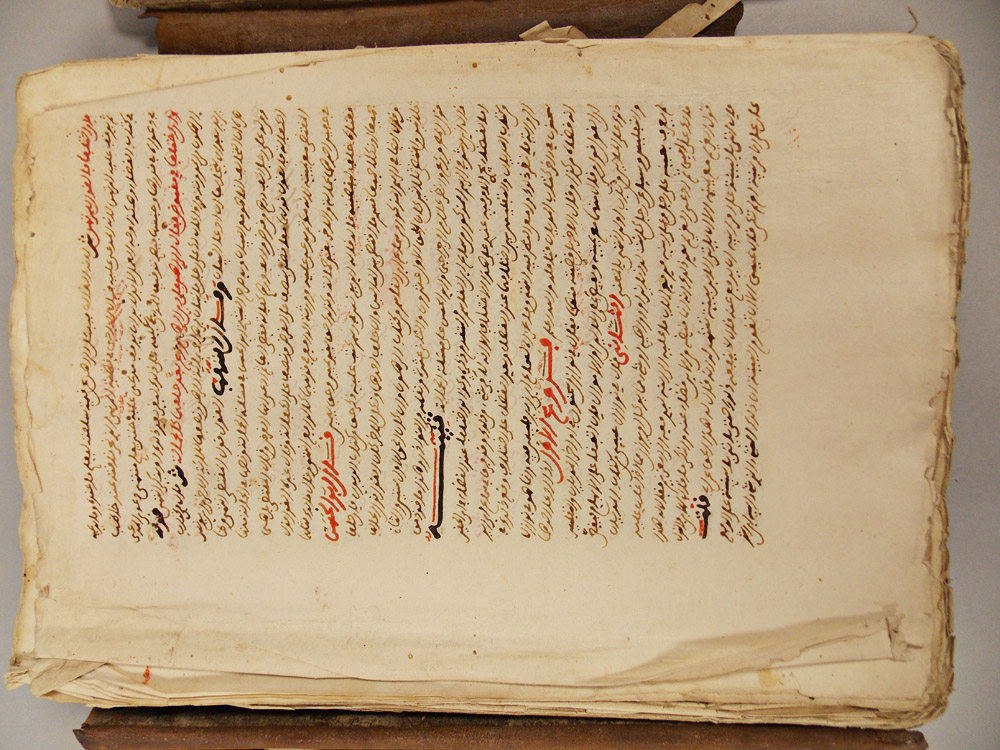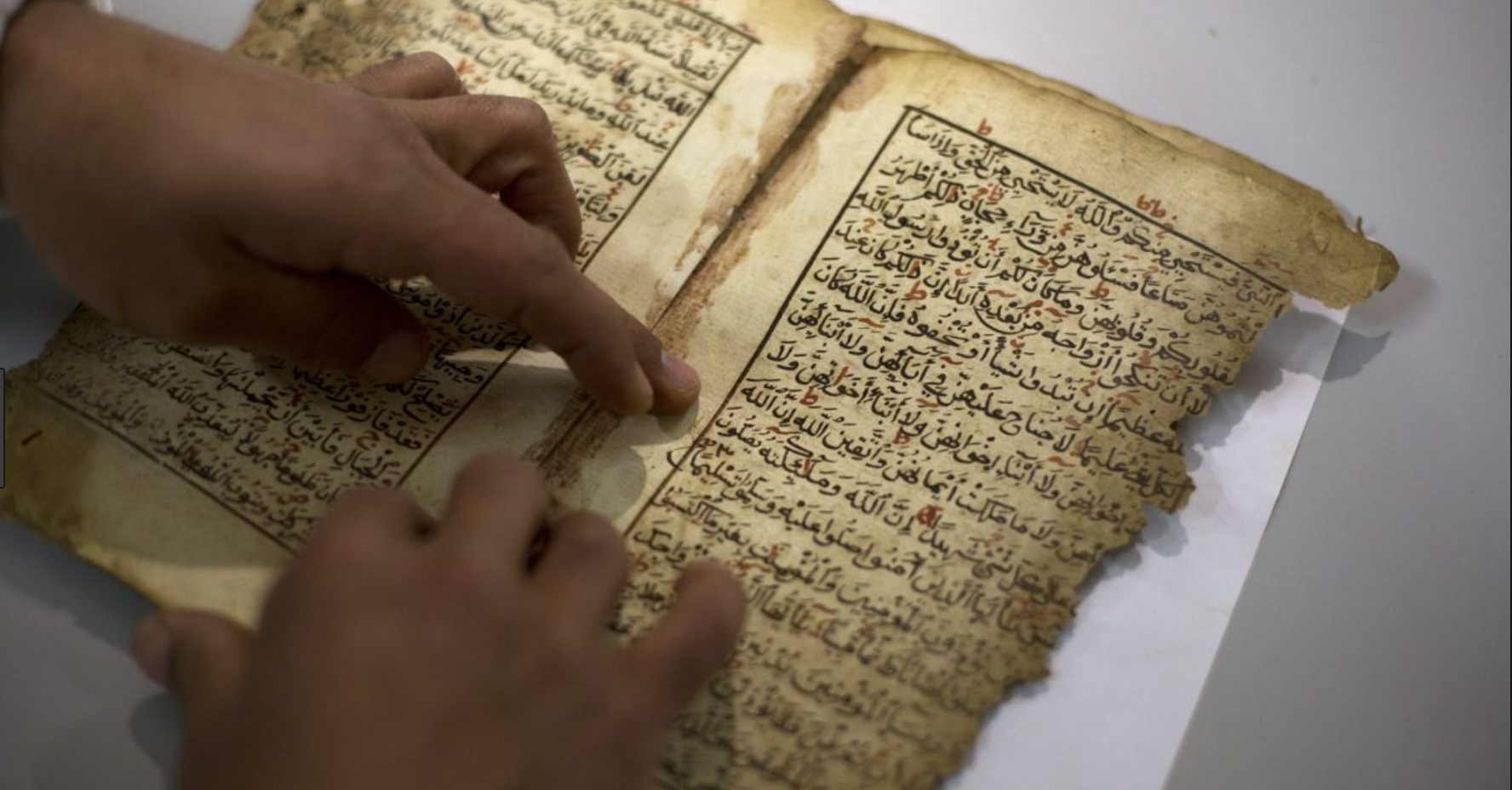
The Maydan is proud to introduce a new initiative highlighting digital resources and projects in the field of Islamic Studies. Included in this roundup are manuscripts collections, digitized manuscripts, and manuscripts catalogues from universities and libraries around the world. *This is an ongoing project – if you know of similar resources that we may have missed please email us at publish@themaydan.com. **In the near future we plan to add to this page essays from scholars who have engaged these manuscript collections/catalogues.
Collections
- Open Islamicate Texts Initiative (OpenITI)
- The Zaydi Manuscript Tradition, Institute for Advanced Study
- The Sinai Palimpsests Project
- Mingana Collection, University of Birmingham
- The Minassian Collection of Qur’anic Manuscripts, Brown University
- Princeton Digital Library of Islamic Manuscripts
- Islamic Medical Manuscripts, US National Library of Medicine
- Beinecke Digital Collections, Beinecke Rare Book & Manuscript Library
- Reading Room, Hill Museum and Manuscript Library
- Institute of Oriental Manuscripts, Saint Petersburg
- Orientalische Handschriften, Universität Tübingen
- Digital Bodleian, University of Oxford
- Chester Beatty Library
- Suleymaniye Library
- Islamic Heritage Project, Harvard Library
- The Orient and Eastern Collections, the Bibliothèque nationale de France
- Middle Eastern Special Collections, Leiden University
- Treasures of Islamic Manuscript Painting from the Morgan
- Digitized Arabic Manuscripts at the AUB Libraries
- Minasian Collection, UCLA
- Digital Vatican Library
- Qatar Digital Library
- Digitalisierte Sammlungen, Staatsbibliothek zu Berlin
- Islamic Manuscripts at the Leipzig University Library
- Marmara University Library and Documentation Department
- Noor Digital Library
- The Oriental Collection, Royal Danish Library
- Arabic Manuscripts Collection, Wellcome Library
- Persian Manuscripts, the British Library
- Islamic Manuscripts, Cambridge Digital Library
- MyManuskrip, University of Malaya Library
- Manuscripts Collections, National Library of Indonesia
Catalogues
- Union Catalogue of Manuscripts from the Islamicate World
- West African Arabic Manuscript Database
- Islamic Scientific Manuscripts Initiative
COLLECTIONS
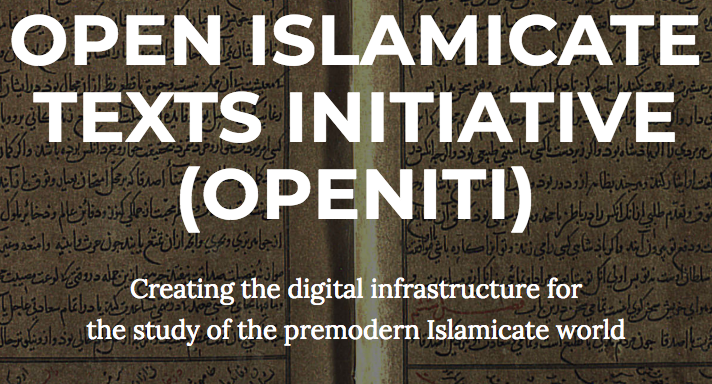
Open Islamicate Texts Initiative
Organized by: Aga Khan University (AKU), Universität Wien (UW), and the Roshan Institute for Persian Studies at the University of Maryland (College Park) and an interdisciplinary advisory board
“Since its founding in 2016, OpenITI’s work has focused on two primary areas: (1) improvement of Arabic-script OCR, and (2) corpus building. Our work on OCR—done in collaboration with Benjamin Kiessling of Universität Leipzig—has produced some of the most accurate results to date on Arabic-script texts (see full results here). Most importantly, these results were achieved on a open-source OCR engine (Kraken) which is retrainable and can be adapted for highly specific scholarly needs.
OpenITI’s second focus flows out of our OCR work (literally): our ultimate goal is the creation of a machine-actionable and standards-compliant scholarly corpus of Persian and Arabic texts.”
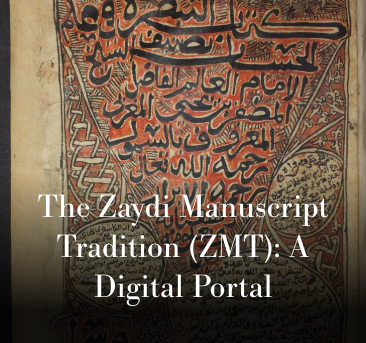
The Zaydi Manuscript Tradition
Organized by: The Institute for Advanced Study
“The Zaydi literary tradition is among the richest and most variegated traditions within Islamic civilization and at the same time one of the least studied. The literary production by Zaydi scholars stretched over more than one thousand years covering a wide spectrum of traditional disciplines, such as law and legal theory, exegesis, Qur’anic sciences and traditions, geography and encyclopedias, medicine and mathematics, history and biography, grammar and philology, theology and literature (prose as well as poetry).”
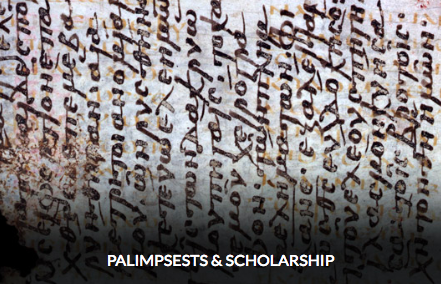
The Sinai Palimpsests Project
Collaboration of St. Catherine’s Monastery of the Sinai and the Early Manuscripts Electronic Library
“The Sinai Palimpsests Project is using state-of-the-art spectral imaging to recover erased texts from palimpsest manuscripts in the library of St. Catherine’s Monastery of the Sinai, the world’s oldest continually operating monastery. The monastery holds an exceptional collection of more than 160 palimpsests, the erased layers of which preserve unstudied texts from the 4th to the 12th century. An online research library, now in development, will make the palimpsests of Sinai globally accessible for study.”
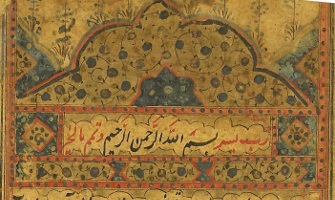
Mingana Collection in the Virtual Manuscript Room
Housed at the University of Birmingham
“The Mingana Collection contains more than 3000 manuscripts in at least eleven languages, ranging from around the 6th to the 20th centuries. The collection is focused on manuscripts from the Middle East in Arabic, Syriac, Persian and Greek and has particular strengths in illustrated manuscripts, and early Islamic and Syraic materials (including one of the oldest Qur’ans in existence). The core of the collection was acquired by Alphonse Mingana (1878-1937) in three trips to the Middle East between 1925 and 1929, with substantial support from Edward Cadbury. The Edward Cadbury Charitable Trust Inc. has continued to provide support for the maintenance and development of the collection, now housed in the University of Birmingham Department of Special Collections.”
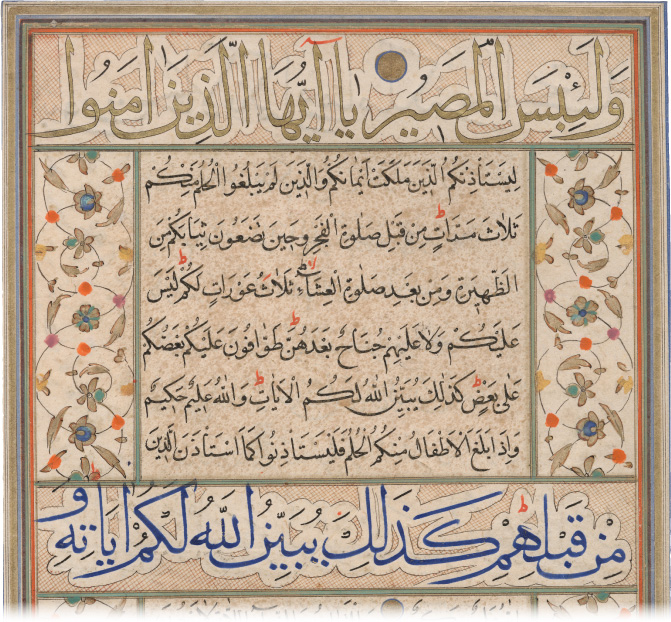
The Minassian Collection of Qur’anic Manuscripts
Housed at Brown University Libraries
“This database catalogues the holdings of over 200 Qur’anic manuscript folios dating from the 9th to the 16th centuries housed within the special collections of the Brown University libraries. These items were acquired as part of a treasury of rich artistic and textual items donated in 1998 to Brown by Adrienne Minassian, the daughter of Kirkor Minassian (1874–1944), who was an active art collector and dealer based in New York and Paris in the early 20th century. In addition to the forty distinct manuscripts of the Qur’an represented here, the collection includes numerous Persian manuscripts, calligraphic panels, Persian and Central Asian ceramics and other art objects, as well as an impressive selection of miniature paintings from the Persian, Mughul and Indian traditions.”
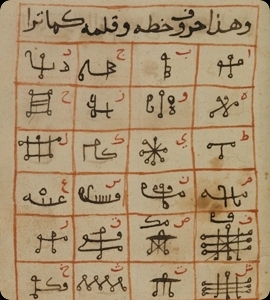
Princeton Digital Library of Islamic Manuscripts
Housed at Princeton University Libraries
“The Princeton University Library has some 9,500 Islamic manuscripts, chiefly bound paper codices, containing a total of more than 20,000 texts. The manuscripts are located in the Manuscripts Division of the Department of Rare Books and Special Collections, at the Harvey S. Firestone Memorial Library. Robert Garrett (Princeton Class of 1897) collected approximately two-thirds of these manuscripts and donated them to the Library in 1942. Since then, the Library has continued to acquire manuscripts by gift and purchase. The manuscripts are chiefly in Arabic but also include Persian, Ottoman Turkish, and other languages of the Islamic world. They date from the early centuries of Islam through the fall of the Ottoman Empire. Most of the manuscripts originated in Arabia, Egypt, Syria, Iraq, Iran, and other main centers of Islamic civilization. But there are examples from Moorish Spain and the Maghreb in the West, to the Indian sub-continent and the Indonesian archipelago in the East, and even sub-Sahara Africa.”
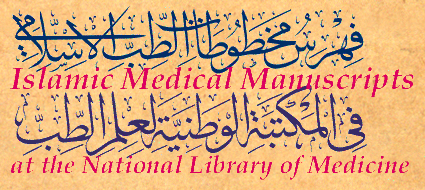
Islamic Medical Manuscripts at the National Library of Medicine
Housed at US National Library of Medicine
“Here you can learn about Islamic medicine and science during the Middle Ages and the important role it played in the history of Europe. This site, with its biographies, colorful images, and extensive historical accounts of medieval medicine and science is designed for students and everyone interested in the history of Islamic and European culture.
For advanced scholars, the site provides a catalogue raisonné (including images) from the 300 or so Persian and Arabic manuscripts in the National Library of Medicine. Most of these manuscripts deal with medieval medicine and science and were written for learned physicians and scientists. Some of the manuscripts are richly illuminated and illustrated.”
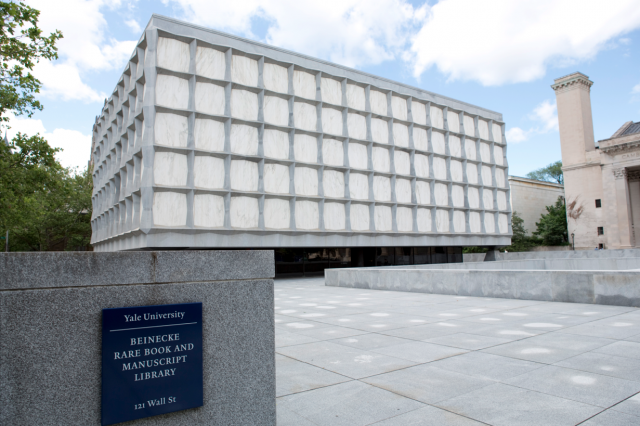
Beinecke Digital Collections
Housed at Yale University
Islamic/Middle Eastern Manuscripts Collection Description
“Yale was a pioneer in the collecting of Islamic or Near Eastern manuscripts beginning in the nineteenth century and as a result, the Beinecke’s collection of Arabic and Middle Eastern manuscripts is among the oldest and richest collections in North America. The collection consists of several large purchases or donations made over a one-hundred year period. The first substantial donation of manuscripts came from Edward Elbridge Salisbury (1814-1901) who was the first professor of Arabic at Yale and who gave donated 97 Arabic manuscripts in 1870. The second large group of manuscripts was purchased for Yale by Morris Ketchum Jessup from Count Landberg (1848-1924), a Swedish Arabic scholar. The third component is made up of manuscripts originally collected by the American Oriental Society (AOS), which included 45 Arabic, 19 Persian and 21 Turkish manuscripts.”
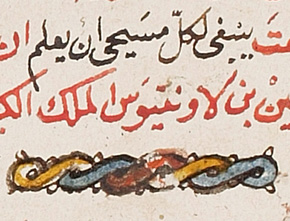
Reading Room, Hill Museum and Manuscript Library
Housed at the Hill Museum & Manuscript Library
“vHMML offers resources and tools for the study of manuscripts and currently features manuscript cultures from Europe, Africa, the Middle East, and South Asia. The site houses high-resolution images of manuscripts, many of them digitized as part of HMML’s global mission to preserve and share important, endangered, and inaccessible manuscript collections through digital photography, archiving, and cataloging. It also contains descriptions of manuscripts from HMML’s legacy microfilm collection, with scans of some of these films.
vHMML is an initiative of the Hill Museum & Manuscript Library. The project began as a partnership between HMML staff and developers from the Center for Digital Humanities at Saint Louis University (James Ginther, PI) and the Carolingian Canon Law Project at the University of Kentucky (Abigail Firey, PI), with initial support from a 2012 National Leadership Grant by the Institute of Museum and Library Services, supplemented by the Arcadia Fund.”
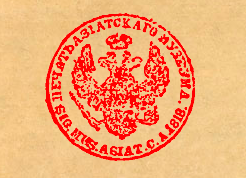
The Manuscript Collection, Institute of Oriental Manuscripts
Housed at Institute of Oriental Manuscripts, Saint Petersburg
“In 1986, The Arabic Manuscripts Kept at the Institute of Oriental Studies. A Brief Catalogue was published, being the completion of the work carried out by several generations of St Petersburg scholars; the collection of Arabic manuscripts had been gathered over more than 150 years and they had been catalogued on many occasions. Ch.D.Frähn, B.A.Dorn, V.R.Rosen, K.G.Salemann, I.J.Krachkovsky and V.I.Belyayev, each in his own time, spoke about the primary importance of the cataloging of Arabic manuscripts kept at the Asiatic Museum (AM) and took some practical measures for this purpose. Like some other Orientalists, they did a lot to open the manuscripts treasures of the AM for experts and broader circles, but the number of manuscripts kept increasing and the entire project had never been brought to fulfillment.
The core of the Arabic and Muslim collection of the AM comprised two collections purchased from the French diplomat J.-L.Rousseau by the Russian government in 1819 and 1825. The first of them, consisting of 500 volumes (276 of which were Arabic treatises), was described by its own possessor at the brief catalogue composed by him for the deal in French. In the same 1819, the AM’s head Ch.D.Frähn gave an account of the collection for the appendix to St Petersburg Vedomosti newspaper and in 1826 published there a popular paper about the second collection of J.-L.Rousseau, consisting of 200 manuscripts, almost entirely in Arabic.”
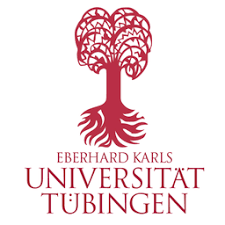
Orientalische Handschriften, Universitätsbibliothek Tübingen
Housed at Universität Tübingen
“Einen Schwerpunkt des Handschriftenbestandes der Universitätsbibliothek Tübingen bilden die orientalischen Handschriften, die im 19. und 20. Jahrhundert als Sammlungen in die Bibliothek gelangten.
Die zahlenmäßig stärkste Gruppe stellen die indischen Handschriften mit inzwischen über 850 Stücken dar, gefolgt von den etwa 400 arabischen und 300 türkischen Handschriften.
Unter den im Jahre 1903 erworbenen 107 armenischen Handschriften sind hervorragende Beispiele zur armenischen Buchmalerei des 12. bis 19. Jahrhunderts enthalten.”
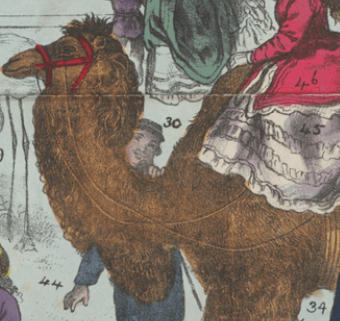
Digital.Bodleian, University of Oxford
Housed at Bodleian Libraries
“The Bodleian Libraries’ collections are extraordinary and significant—both from a scholarly point of view and as material that has an historic and aesthetic richness that holds value for non-academic users. Each year the Libraries serve more than 65,000 readers, over 40% of them from beyond the University, while its critically-acclaimed exhibitions attract almost 100,000 visitors annually. In an effort to make portions of our collections open to a wide variety of users from around the world for learning, teaching and research, the Bodleian Libraries have been digitizing library content for nearly twenty years. The result is over 650,000 freely available digital objects and almost another 1 million images awaiting release.”
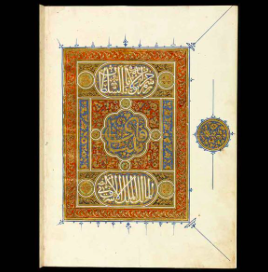
Chester Beatty Library
Housed at Chester Beatty Library
“To maintain and preserve the collections of the Library and to make them available in the most appropriate ways for the use and enjoyment of the public and for scholarly study and research, in order to promote a wider appreciation and understanding of the international cultural heritage embodied in the collections and to foster relations between Ireland and the peoples whose cultures are represented in the collections.”
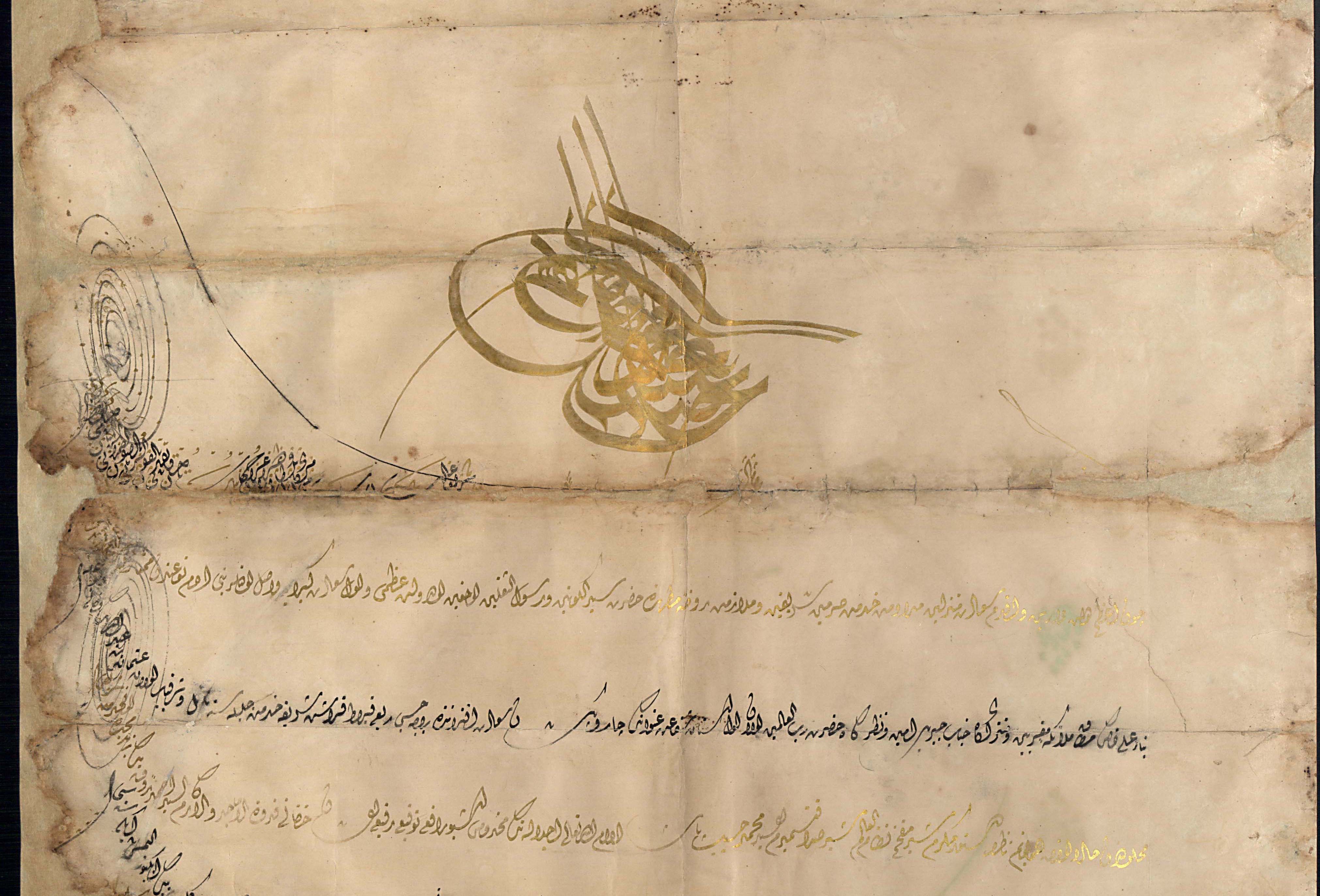
Süleymaniye Library
Housed at Süleymaniye Library
Suleymaniye library (Suleymaniye Kütüphanesi) is home to Turkey’s largest manuscript collections. It contains 76,392 manuscripts and 63,380 print materials. The building is the former home of the two madrasa wings of the Suleymaniye complex (külliye). Its large collection contains many manuscripts from other libraries around Anatolia that were closed off or were unable to preserve the valuable manuscript collections. The Suleymaniye Collection is the largest collection at the library and includes valuable and rare manuscripts in Ottoman, Arabic and Persian among other languages.
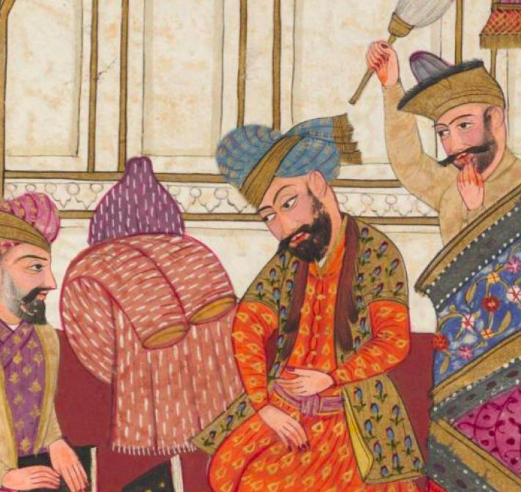
Islamic Heritage Project, Harvard Library
Housed at Harvard Library
“Materials in Islamic Heritage Project digital collection date from the 10th to the 20th centuries and represent many: regions, including Saudi Arabia, North Africa, Egypt, Syria, Lebanon, Palestine, Iran, Iraq, Turkey, and South, Southeast, and Central Asia; languages, primarily Arabic, Persian, and Ottoman Turkish; also Urdu, Chagatai, Malay, Gujarati, Indic languages, and several Western languages; and subjects, including religious texts and commentaries; Sufism; history, geography, law, and the sciences (astronomy, astrology, mathematics, medicine); poetry and literature; rhetoric, logic, and philosophy; calligraphy, dictionaries and grammar, as well as biographies and autobiographical works.”
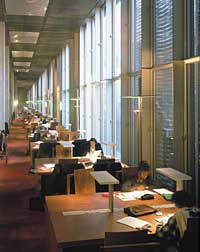
The Orient and Eastern Collections, the Bibliothèque nationale de France
Housed at the Bibliothèque nationale de France
“The eastern collections held at the Richelieu Library (Site Richelieu) include manuscripts in more than a hundred ancient and modern languages.
These are among the world’s most important collections in terms of their diversity, quality, and size, and are continuing to grow.
They are characterized by the following:
- a variety of forms and media: codexes, rolls, bone fragments, palm leaves, parchment, paper, etc.
- around a hundred different languages and alphabets: Africa, North and South America, from Anatolia to Nepal, and from Malaysia to Japan
- ancient languages: ancient Egyptian, Assyrian, Syriac, Sabean, Samaritan, etc.
They represent a rich pool of sources for studying the history, literature, languages, iconography, and religions of these cultures.
The most valuable collections include the following: fragments of the Dead Sea manuscripts, manuscripts in Arabic, Coptic, Ethiopian, Hebrew, Persian, Syriac, and Turkish purchased by emissaries to the Levant as far back as the 16th century, and illuminated manuscripts of the Maqamat of Hariri (Arabic), the Shahnameh of Ferdowsi (Persian), the Miraj Nameh (Turkish), the Hebrew Bible, etc.”
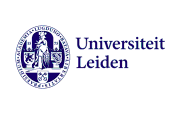
Middle Eastern Special Collections, Leiden University Libraries
Housed at Leiden University Libraries
“The collections comprise c. 6500 manuscripts and a much larger number of early printed books from regions as diverse as the Middle East and North Africa, Central Asia and Western China, and the Jewish World. It also covers the output of Western Orientalist scholarship from the dawn of printing in Europe until c. 1950.
Predominant is the written heritage in the main languages of the areas under consideration: Arabic, Persian, (Ottoman) Turkish and other Turkic languages, with smaller holdings in Hebrew and Aramaic, Syriac, Ethiopic, South Arabic, Armenian and Berber languages. Although Islam, Christianity and Judaism have left a strong mark on the collections, they cover the entire range of the human scholarly endeavour, from the exact sciences to literature, history and art.”
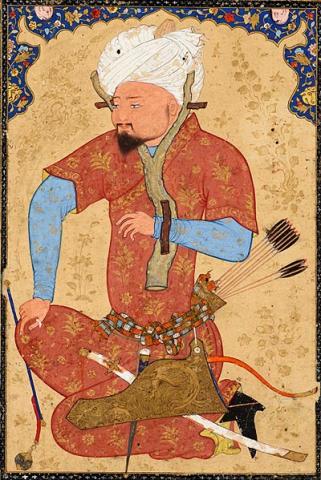
Treasures of Islamic Manuscript Painting, The Morgan Library & Museum
Housed at the Morgan Library & Museum
“Although the Morgan is well known for its collection of medieval and Renaissance manuscripts, it also holds important Islamic manuscripts full of extraordinary paintings. Since Islam refers to both the religious faith and civilization of Muslims, this online exhibition includes both religious and secular texts. Just as the Qur’an is central to Islamic life, it is also the centerpiece of this presentation, followed by manuscript pages that illustrate works of science, biography, history, and poetry. Included are such important manuscripts as the Manāfi˓-i hayavān (The Benefits of Animals)—one of the finest surviving Persian examples—and the richest illustrated life of the beloved poet Rūmī (1207–1273). Also featured are pages from the Mughal and Persian albums that Pierpont Morgan acquired in 1911 from Sir Charles Hercules Read, Keeper of British and Medieval Antiquities at the British Museum, and miniatures illustrating the work of great Persian poets.”
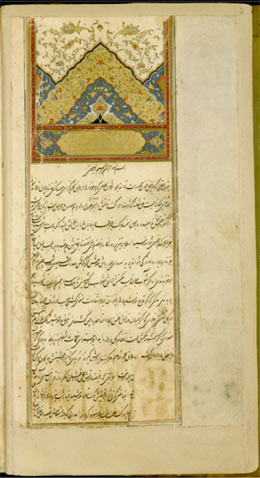
Caro Minasian Collection Digitization Project, UCLA Libraries
Housed at the University of California, Los Angeles
“The University of California, Los Angeles Library holds one of the two largest collections of Near Eastern manuscripts in the United States.1 The UCLA collections include approximately 7,000 manuscripts written in Ottoman Turkish, Persian, Arabic, and Armenian, primarily in the fields of medicine, literature, philology, theology, law, and history, and ranging from the 11th through the 19th centuries. These collections rank among the most important in North America, both in extent and scholarly interest. Inquiries about the collections come from around the globe and in a variety of fields, even though the collections are little known and lack adequate bibliographic access.
In an effort to make the Near Eastern manuscripts collections better known to a variety of audiences, the UCLA Library has initiated a long-term, large-scale plan to improve access to these collections through cataloging, digitization, and the development of tools that will support research and instruction in the online environment.”
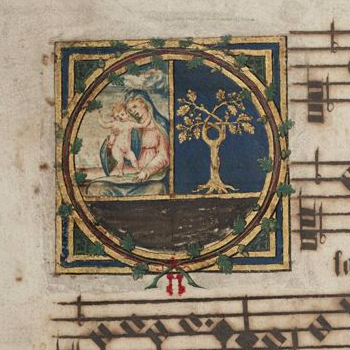
Digital Vatican Library
Housed at the Vatican Libraries
“DigiVatLib is a digital library service. It provides free access to the Vatican Library’s digitized collections: manuscripts, incunabula, archival materials and inventories as well as graphic materials, coins and medals, printed materials (special projects).
DigiVatLib is based on the International Image Interoperability Framework (IIIF) technology, making digital materials easily accessible and usable.”
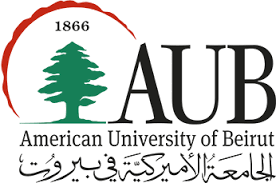
Digitized Arabic Manuscripts, American University of Beirut
Housed at American University of Beirut
“The University Libraries owns approximately 1,400 manuscripts in several languages, the majority of which are in Arabic. The core clusters were acquired from the prestigious private libraries of the Syrian Society for the Arts and Sciences (1847- 1852); Nawfal Nimatallah Nawfal’s (1811-1887) and the distinguished Lebanese historian Issa Iskandar al-Ma’luf (1869-1956). The manuscripts cover a wide range of subjects, e.g. theology, Arabic language and literature, history, geography and the various sciences, and attract researchers from all over the world. Some have become well-known and have acquired a name of their own such as the Beirut Codex, a New Testament in Syriac, dating back to the 9th or 10th c. A pdf copy of the catalog of our manuscript collection compiled by Dr. Yusuf Khoury and listing the AUB Libraries manuscripts, entitled ‘al-Makhtutat al-‘Arabiyah al-mawjudah fi maktabat al-Jami’ah al-Amirikiyah fi Bayrut’ and published in 1985, can be found on the website.”

Qatar Digital Library
Hosted by Qatar National Library
“The Qatar Digital Library (QDL) is making a vast archive featuring the cultural and historical heritage of the Gulf and wider region freely available online for the first time. It includes archives, maps, manuscripts, sound recordings, photographs and much more, complete with contextualised explanatory notes and links, in both English and Arabic.
Our aim is to make a world-class resource freely available for everyone – from those with a general interest in the history of the Gulf to the academic researchers undertaking ground-breaking research. The QDL will transform the study of Gulf history, improving understanding of the Islamic world, Arabic cultural heritage and the modern history of the Gulf.
The QDL has been developed as part of a 10-year Memorandum of Understanding on Partnerships between the Qatar Foundation, the Qatar National Library and The British Library.
QDL includes Arabic Scientific Manuscripts from the British Library’s Manuscripts Collections, covering topics such as medicine, mathematics, astronomy and engineering.”
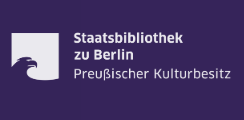
Digitalisierte Sammlungen, Staatsbibliothek zu Berlin
Housed at Staatsbibliothek zu Berlin – Prussian Cultural Heritage Foundation
“As the largest scientific universal library in Germany, the Staatsbibliothek zu Berlin – Preußischer Kulturbesitz (Berlin State Library – Prussian Cultural Heritage) is a central supplier of national and international literature.
More than 11 million volumes of printed material alone have accumulated since the library was founded in 1661. The collection comprises over 2.2 million additional printed works and other, often unique, materials in the special collections – these include western and oriental manuscripts, music autographs, estates and deposits, personal collections, maps, and historic newspapers. The library’s collection also contains more than 10 million microforms and, in the picture library, over 12 million motifs. Furthermore, a constantly increasing number of databases and other electronic resources complement the collection. The quality of its collections and its diverse services characterise the special prestige of the library worldwide.”
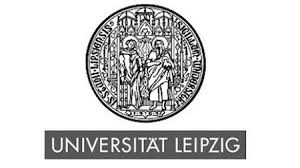
Islamic Manuscripts at the Leipzig University Library
Housed at Leipzig University
“Project for the digitisation and online presentation of Arabic, Persian, and Turkish manuscripts at Leipzig University Library
From October 2012 until January 2015, the remaining Arabic, Persian, and Turkish manuscripts at Leipzig University Library that have not been catalogued and/or digitized yet, will be subject to a final online cataloguing and digitization process. Thereby, all Arabic, Persian, and Turkish manuscripts at Leipzig University Library will be online accessible by 2015. This project works with an abbreviated cataloguing template is complemented with complete digital images. The project is supported by the German Research Foundation (Deutsche Forschungsgemeinschaft, DFG).
Parts of the University Library’s holdings have been previously catalogued and digitised in two projects: the “Refaiya Project” ( www.refaiya.uni-leipzig.de ) and the “Project for the online cataloguing and digital presentation of newly acquired Arabic, Persian, and Turkish manuscripts at Leipzig University Library” ( www.islamic-manuscripts.net ).”
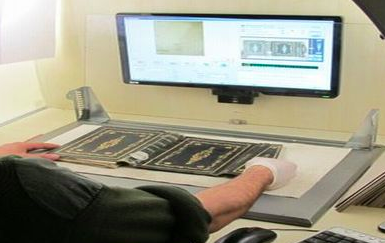
Marmara University Library and Documentation Department
Housed at Marmara University Library
“Marmara University Rare Manuscripts Collection (Marmara Üniversitesi Nadir Eserler Koleksiyonu), brings together all the manuscripts collected and donated to the university since its founding in 1883 as the Hamidiye Ticaret Mekteb-i Âlisi.
Its collection is mainly composed of manuscripts and print books in Ottoman Turkish.”
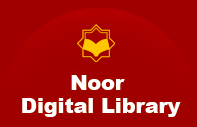
Noor Digital Library
Hosted by Mar’ashi Library
Background
A great amount of major Islamic texts have so far been contained in different computer programs under different subjects in this Center. With a background of developing library programs and websites like Noormags, Computer Research Center of Islamic Sciences began to develop Noor Digital Library in 2006 in order to facilitate the researcher’s access to specialized resources on Islamic sciences and the Humanities.
The website now contains over 8000 books in 16000 volumes on such subjects as Qur’anic sciences and exegesis, hadith sciences, Du`asand ziyarats, Nahj al-Balaghah, theology and philosophy, geography, history and conduct, Islamic jurisprudence, usoul (legal theory), Islamic ethics and mysticism, literature, logic, and Islamic denominations and sects.
On the Website
The research capabilities embedded in Noor programs and other network-based features that are not available even on desktop programs, like research projects and personal bookcases, have been used in designing this website.
All the books are available in text format with specialized tags along with the scanned images of them; so that the users may view both the text and image formats of any book at the same time.
Perspective
The website is to provide the scientific communities of the world with all reliable resources of Islamic sciences with specialized research tools. In the future phases of the website development, a great amount of resources on other fields as the Humanities will be added.”
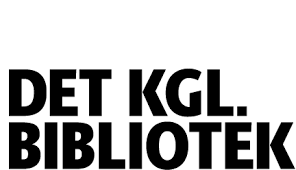
The Oriental Collection, Royal Danish Library
Housed at the Royal Danish Library
“The Oriental collections in The Royal Library comprise manuscripts, block prints, and printed books in languages of Asia and North Africa. The collections are acquired for research in language, religion, and culture in its widest sense, including history.
The collection is divided into five main sections:
- The Near Eastern collection comprises Arabic, Turkish, Persian and Caucasian (mainly Armenian and Georgian) texts.
- The South Asian collection comprises mainly texts in Indian languages (Pali, Sanskrit and modern Indian) as well as in Nepali, Sinhalese, Tamil, and Urdu.
- The Central Asian collection comprises mainly manuscripts and blockprints from Tibet and Mongolia, plus Manchu-Tungus texts.
- The South East Asian collection comprises manuscripts from Indonesia, Myanmar (Burma), Cambodia, Laos and Thailand. Printed books in Vietnamese.
- The East Asian collection comprises mainly texts in Chinese, Japanese and Korean.
Nearly all printed items may be located in the database of the library REX.”
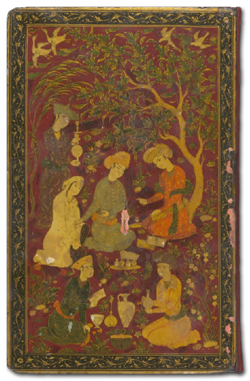
Arabic Manuscripts Collection, Wellcome Library
Housed at Wellcome Library
“Nearly 500 volumes of Arabic manuscripts covering not only medicine and pharmacology, but cosmology, alchemy, cookery and more are available online.
The digitised Arabic manuscripts range in date from the 10th to 20th centuries and cover subjects as diverse as: medicine and pharmacology, alchemy, physiognomy, cosmetics, cookery, and cosmology.
They include witnesses to some of the greatest works of Arabic medicine, such as Ar-Razi’s Kitab al-Hawi, Ibn Sina’s Al-Qanun and its various commentaries, Arabic translations of Galen and Paracelsus, and many more.
In addition there are homely recipe collections of practising physicians from the world of Islam ranging from North Africa to the Indian subcontinent. A large number of the Levantine books were collected by Dr Sami Ibrahim Haddad (1890-1957), a well-known Lebanese physician and historian of medicine.”
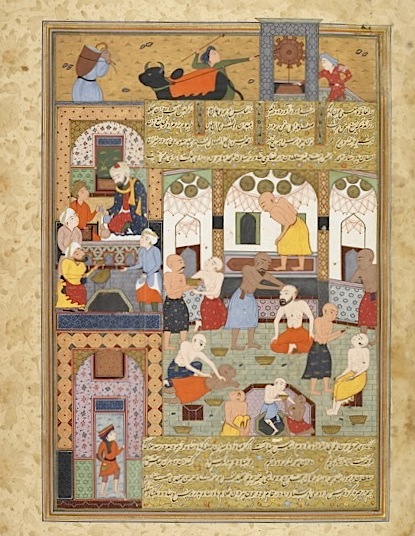
Persian Manuscripts, the British Library
Housed at the British Library
“From the pocket miscellany, with its exquisite miniature illuminations, compiled in 1410-11 for Timur’s grandson Sultan Jalal al-Din Iskandar, ruler of Fars, to unique historical documents and literary manuscripts, the Persian Manuscripts collection at the British Library is one of the most significant collections in the world in both size and importance. Consisting of over 11,000 works in almost as many volumes, it combines the two world-class collections of the British Museum and the India Office Library. These manuscripts originate from the whole of the Persianate world, in particular Iran, Central Asia and India and range in time from the 12th century to recent years, representing most of the traditional fields of humanities and religious studies. Many of the Persian manuscripts are copies of rare texts, with examples of some of the finest illustrated Mughal, Timurid and Safavid paintings.
Although printed catalogues exist for most of this material, only some of the catalogues are available online. Moreover, very little of the collection has been digitised. Our Persian manuscripts have, until recently, only been accessible onsite to those who can physically visit the British Library to study in the Asian and African Studies reading room. With limited access to catalogue records, the collection has therefore been much underused.”
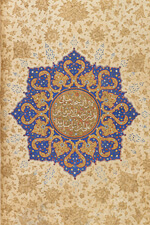
Islamic Manuscripts, Cambridge Digital Library
Housed at University of Cambridge Libraries
“Cambridge University Library’s collection of Islamic manuscripts dates from the origins of Arabic scholarship in Cambridge in the 1630s when the University founded a Professorship in Arabic and William Bedwell donated a Qurʼān to the Library. Since that time the collection has grown in size and diversity to over 5,000 works, including the collections of Thomas Erpenius, J.L.Burckhardt, E.H.Palmer and E.G. Browne. These manuscripts shed light on many aspects of the Islamic world, its beliefs and learning.
The collection was further enriched over the centuries through the activities of scholarly collectors and skilled librarians, adding more depth to the already impressive range of manuscripts. Yet this extraordinary collection has remained relatively unknown outside Cambridge. Now we hope to draw better attention to its treasures through cataloguing and digitisation. We have collaborated with the Bodleian at Oxford and other research libraries to provide an online catalogue of the collection. We will be offering a selection of digitised manuscripts through the Foundations project and will seek funding for further digitisation.”
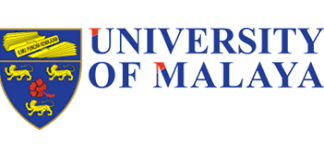
MyManuskrip, University of Malaya Library
Hosted by University of Malaya Library
“.MyManuskrip or Digital Library of Malay Manuscript enables repositories within Malaysia and those outside to participate in building and offering manuscript content as well as outputs of manuscript research such as articles, reports, theses and links to relevant sites. As such, repositories, cultural and national heritage centers, manuscript libraries and museums are invited to share and provide access to their manuscript contents and expert knowledge concerning Malay scriptorium.
Malay manuscripts are handwritten documents mostly written in the Jawi-Arabic script and dates as early as the 15th century. It is invaluable (rare) and a national heritage that must be preserved for posterity. The manuscripts extend over diverse areas, studies on Malay language, Islamic studies, Astrology, Folk literature (syair, gurindam, hikayat), traditional medicine, handwritten Quran and its interpretations, historiography, laws and discourses on Malay society and culture.”

Manuscripts Collection, National Library of Indonesia
Housed at National Library of Indonesia
The manuscript collections at the National Library of Indonesia present rich resources in Islamic sciences and on South Asian Islamicate works.
CATALOGUES
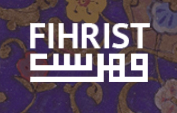
Union Catalogue of Manuscripts from the Islamicate World
Collaboration of several UK universities and organizations
“We have used the phrase “manuscripts from the Islamicate World” to more accurately describe the content of this catalogue. The rich collections of manuscripts bear witness to the linguistic, religious and cultural diversity of what commonly features as the Islamic world.
The combined holdings of the contributing Libraries of the UK are of considerable intellectual and cultural significance. All participating libraries have been selectively collecting manuscripts from all subject areas, and of various geographical origins, dating from the 7th to the 19th century CE.
FIHRIST evolved from a joint Oxford-Cambridge pilot-project (Oxford Cambridge Islamic Manuscript Catalogue on-line – OCIMCO, funded by JISC [2009-11]), into a UK-wide union catalogue, continuously expanding in volume, as libraries and research projects are contributing manuscripts descriptions.”
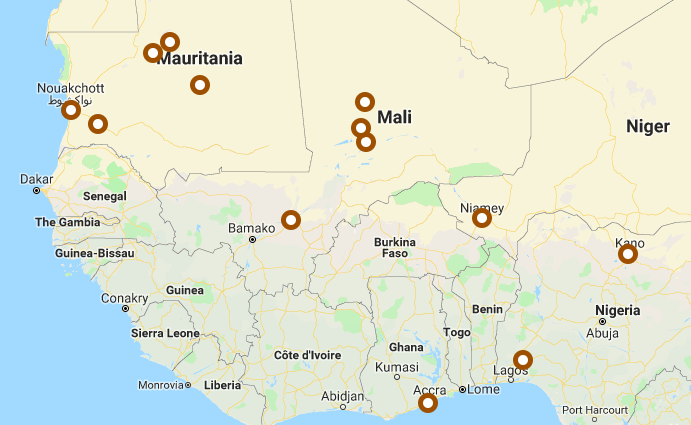
The West African Arabic Manuscript Database
Organized by and in collaboration with the National Endowment for the Humanities, University of Illinois at Urbana-Champaign, The Johns Hopkins University, Duke University, al-Furqan Islamic Heritage Foundation, and the University of California at Berkeley
“WAAMD is a bi-lingual database that was developed at the University of Illinois in the late 1980s to describe a collection of Arabic manuscripts in southern Mauritania (Boutilimit). It subsequently has been used to compile a union catalogue of other West African collections, including manuscript libraries in West Africa, Europe and the United States. Beginning in 2018 inventories from the SAVAMA-DCI project in Timbuktu are being added. This is a work in progress that will be expanding as additional library data from West Africa is being made available. WAAMD is hosted by the Library of the University of California, Berkeley.
The database is publicly available at no cost to users; and the WAAMD cataloguing app is free to be downloaded for local use. Thirty-odd fields in Arabic and English cover all the descriptors normally employed in manuscript work and users may customize the input fields for the needs of particular collections. We encourage the inclusion of newly-catalogued material into the main database and ask readers to contact the editors to help facilitate this.”
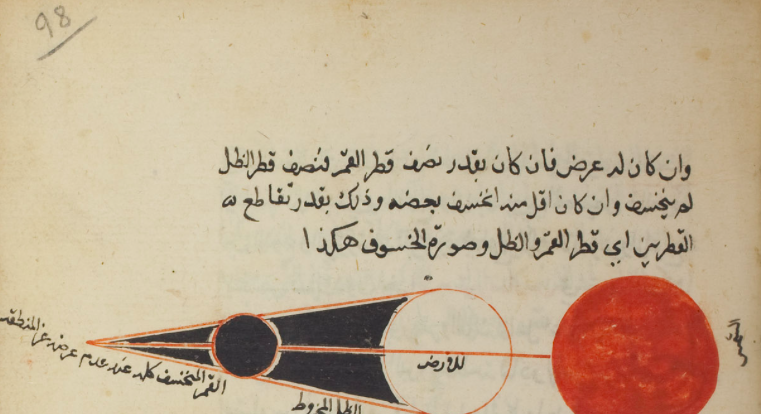
Islamic Scientific Manuscripts Initiative
Housed at Max Planck Institute for the History of Science (MPIWG); collaborative project led by Profs. Jamil Ragep (McGill), Sally Ragep (McGill), and Lorraine Daston (MPIWG).
“The ISMI database provides a means to access Islamicate authors, their works, and extant manuscript witnesses in the various fields of the mathematical sciences. These fields include the “pure” mathematical sciences (such as geometry, arithmetic, algebra, and trigonometry) as well as the “mixed” mathematical sciences (such as astronomy, optics, music, and mechanics). It is thus an online successor to Heinrich Suter’s Beiträge zur Geschichte der Mathematik und Astronomie im Islam and G. P. Matvievskaya and B. A. Rosenfeld, Matematiki i astronomi musulmanskogo srednevekovya i ikh trudi (VIII-XVII vv.) [Mathematicians and Astronomers of the Muslim Middle Ages and Their Works (VIII-XVII centuries)], 3 vols. [The latter englished and expanded as Boris A. Rosenfeld and Ekmeleddin İhsanoğlu, Mathematicians, astronomers and other scholars of Islamic civilization and their works (7th-19th c.).]
The database was also designed to facilitate research on these materials. In particular, it allows for “transitive queries” that return chains of teachers/students, original texts (matn)/commentaries, ownership chains, and so forth. A Query Builder allows the researcher to query the data in numerous ways; one could, for example, search for all works on astronomical instruments copied between 1250-1350. Of course, the quality of the results depends on the stored data, which will continue to expand over time. Visualization tools are also being developed as aids for this research. You can find a preliminary set of tools in the “ISMI Lab” section.”


